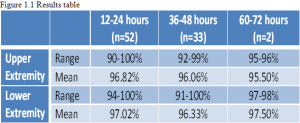Laura Hess and Dr. Patricia Ravert, College of Nursing
Oxygen saturation is an important indicator of the overall health of a newborn, so important that it is considered a vital sign. The normal limit for oxygen saturation (SpO2) in babies born at lower altitudes is 90-100%. Anything less than 90% is considered a sign that the infant is not receiving enough oxygen. At this time, the mean oxygen saturation level of well neonates born at higher altitudes (above 4498 ft) is not known. Infants who have SpO2 measurements of less than 92% without symptoms of respiratory distress may be treated with oxygen and infants may even go home with oxygen. Because we don’t know what the average SpO2 is for infants born at higher altitudes, we don’t know if this supplemental oxygen is necessary. This use of oxygen that may or may not be needed increases healthcare costs and is burdensome for parents. The purpose of this pilot study was to determine the mean SpO2 of well babies born at 4498 feet and contribute data to a larger study here in Utah and in higher altitudes in Colorado.
After obtaining IRB approval, I collected data at Utah Valley Regional Medical Center in the well baby nursery. I obtained consent with the parents, then collected data at two different times: 12-24 hours old, and 36-48 hours old if they were still in the hospital. In order to be included, the newborn must have been considered healthy, without extensive respiratory interventions after birth. I took an oxygen reading on both a hand and a foot. I also recorded information such as sleep state, sex, season, gestational age, and birth weight to account for factors that could affect the SpO2. My sample included 52 babies. Data is still being collected at UVRMC and at various locations in Colorado.
The results of my initial study are shown in the table below. The averages for the different data collection times and sites (hand vs. foot) were between 95.50%-97.50%. I only identified the

mean, I did not take into account factors such as sleep state and birth weight. This will be done as more data is collected. I presented my findings at a poster session at the Utah Nurses Association annual conference on October 25-26.
As this research project continues, it will be interesting to see how results from higher mountain towns in Colorado will affect the mean. If the average is shown to be above 92%, we will know that the supplemental oxygen that is routinely given is necessary. If the average is shown to be lower, hopefully our research will be able to play a part in changing the policy. I have greatly appreciated this opportunity to do research. It has shown me the important part that research should play in influence the way we practice in health care. I look forward to the future when my own research will influence my own individual practice as a nurse.
